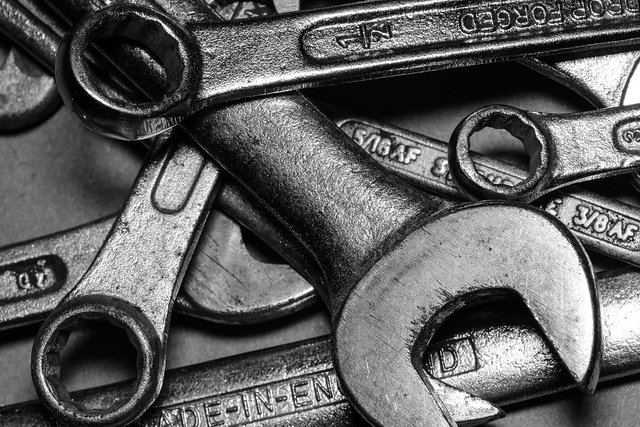The Future Of Jobs: Technological Unemployment
An article about necessary future skills sparked my interest.

According to the World Economic Forum.
The top 10 skills that will be most desired by employers by 2020 are in descending order:
10. Cognitive flexibility
This involves creativity, logical reasoning, and problem sensitivity. It also means being able to adapt how you communicate based on who you're talking to. Employers want to know you don't just say the same thing to everyone -- that you think critically about who you're talking to, deeply listen, and tailor communication to that person.
9. Negotiation skills
This will be in especially high demand in computer and math jobs, such as data analysis and software development. It will also be critical in the arts and design (including commercial and industrial designers).
8. Service orientation
This was defined as actively seeking ways to help others. How much do you assist those on your team, your superiors, and people across your industry? How much are you known for that?
7. Judgment and decision-making
As organizations collect more and more data, there will be an even greater need for workers who can analyze it and use it to make intelligent decisions. Good judgment also involves knowing how to get buy-in from a colleague, or making a strong suggestion to a manager (even if it might not make you popular).
6. Emotional intelligence
Robots can do a lot, but they still can't read people the way other humans can (at least not yet). Employers will place a strong emphasis on hiring those who are aware of others' reactions, as well as their own impact on others.
5. Coordinating with others
Again, this falls under the social skills umbrella (sensing a trend?). It involves being able to collaborate, adjust in relation to others, and be sensitive to the needs of others.
4. People management
In the report, this included being able to motivate people, develop the talents and skills of employees, and pick the best people for a job. This will be especially in demand for managers in the media and energy industries.
3. Creativity
In 2015, creativity ranked 10th on the list. It's now one of the top three skills employers will seek. Why? Because as we're bombarded by new technologies, employers want creative people who can apply that tech to new products and services.
2. Critical thinking
As automation increases, the need for humans who can employ logic and reasoning increases. This is, in part, because machines must be directed ethically and optimally. Employers want people with critical minds who can evaluate the uses or abuses of the power of technology, and use them to benefit the company, the people in it, and the future.
1. Complex problem-solving
Technology can make life easier, but it can also make things more complicated. For example, you could use wearables to help map the walking patterns of nurses and doctors in a hospital to see how to make things more efficient. But without a human being analyzing those results while also having intelligent conversations with nurses, doctors, and patients, you will likely end up with a wrong or even dangerous result.
36 percent of all jobs across all industries will require complex problem-solving abilities as a core skill by 2020.
I would rate Emotional intelligence a bit higher.
I have seen to many knobs in leadership jobs running the madhouse.
And just being totally ignorant of the reactions that are happening around them.
Because of idiotic decision making.
But now is your chance to update your CV with the new Psychobabble Buzz words needed to nail that all important Interview.
The rest then is in the lap of the Job Gods.
Back in 2014 there was an interesting article in the Economist in which it covered,
The Future of Jobs.
And one of John Maynard Keynes worries about,
a “new disease”: “technological unemployment…due to our discovery of means of economising the use of labour outrunning the pace at which we can find new uses for labour.”

From the Economist Article:
The Lathe Of Heaven:
Economists take the relationship between innovation and higher living standards for granted in part because they believe history justifies such a view. Industrialisation clearly led to enormous rises in incomes and living standards over the long run. Yet the road to riches was rockier than is often appreciated.
In 1500 an estimated 75% of the British labour force toiled in agriculture. By 1800 that figure had fallen to 35%. When the shift to manufacturing got under way during the 18th century it was overwhelmingly done at small scale, either within the home or in a small workshop; employment in a large factory was a rarity. By the end of the 19th century huge plants in massive industrial cities were the norm. The great shift was made possible by automation and steam engines.
Industrial firms combined human labour with big, expensive capital equipment. To maximise the output of that costly machinery, factory owners reorganised the processes of production. Workers were given one or a few repetitive tasks, often making components of finished products rather than whole pieces. Bosses imposed a tight schedule and strict worker discipline to keep up the productive pace. The Industrial Revolution was not simply a matter of replacing muscle with steam; it was a matter of reshaping jobs themselves into the sort of precisely defined components that steam-driven machinery needed—cogs in a factory system.
The way old jobs were done changed; new jobs were created. Joel Mokyr, an economic historian at Northwestern University in Illinois, argues that the more intricate machines, techniques and supply chains of the period all required careful tending. The workers who provided that care were well rewarded. As research by Lawrence Katz, of Harvard University, and Robert Margo, of Boston University, shows, employment in manufacturing “hollowed out”. As employment grew for highly skilled workers and unskilled workers, craft workers lost out. This was the loss to which the Luddites, understandably if not effectively, took exception.
With the low-skilled workers far more numerous, at least to begin with, the lot of the average worker during the early part of this great industrial and social upheaval was not a happy one. As Mr Mokyr notes, “life did not improve all that much between 1750 and 1850.” For 60 years, from 1770 to 1830, growth in British wages, adjusted for inflation, was imperceptible because productivity growth was restricted to a few industries. Not until the late 19th century, when the gains had spread across the whole economy, did wages at last perform in line with productivity (see chart 1).
Along with social reforms and new political movements that gave voice to the workers, this faster wage growth helped spread the benefits of industrialisation across wider segments of the population. New investments in education provided a supply of workers for the more skilled jobs that were by then being created in ever greater numbers. This shift continued into the 20th century as post-secondary education became increasingly common.
Claudia Goldin, an economist at Harvard University, and Mr Katz have written that workers were in a “race between education and technology” during this period, and for the most part they won. Even so, it was not until the “golden age” after the second world war that workers in the rich world secured real prosperity, and a large, property-owning middle class came to dominate politics. At the same time communism, a legacy of industrialisation’s harsh early era, kept hundreds of millions of people around the world in poverty, and the effects of the imperialism driven by European industrialisation continued to be felt by billions.
The impacts of technological change take their time appearing. They also vary hugely from industry to industry. Although in many simple economic models technology pairs neatly with capital and labour to produce output, in practice technological changes do not affect all workers the same way. Some find that their skills are complementary to new technologies. Others find themselves out of work.
Take computers. In the early 20th century a “computer” was a worker, or a room of workers, doing mathematical calculations by hand, often with the end point of one person’s work the starting point for the next. The development of mechanical and electronic computing rendered these arrangements obsolete. But in time it greatly increased the productivity of those who used the new computers in their work.
Many other technical innovations had similar effects. New machinery displaced handicraft producers across numerous industries, from textiles to metalworking. At the same time it enabled vastly more output per person than craft producers could ever manage.
Read The Whole Article:
https://www.economist.com/news/briefing/21594264-previous-technological-innovation-has-always-delivered-more-long-run-employment-not-less
Images Courtesy of Pixabay
you did a very good top
If we made memes the worldwide currency, then each human could mine their own!